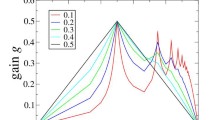Abstract
Random walks with discrete time steps and discrete state spaces have widely been studied for several decades. We investigate such walks as games with “Diffusion Control”: a player (=controller) with certain intentions influences the random movements of the particle. In our models the controller decides only about the step size for a single particle. It turns out that this small amount of control is sufficient to cause the particle to stay in “premium regions” of the state space with surprisingly high probabilities.
Access this chapter
Tax calculation will be finalised at checkout
Purchases are for personal use only
Similar content being viewed by others
Notes
- 1.
For brevity, we use ‘he’ and ‘his’, whenever ‘he or she’ and ‘his or her’ are meant.
References
Althöfer, I.: Havannah - the old man and the C’s. ICGA J. 35, 114–119 (2012)
Althöfer, I.: Theoretical analysis of the (1,3)-casino model. Working paper, Jena University, Faculty of Mathematics and Computer Science, September 2014
Althöfer, I., Marz, M., Kaitschick, S.: Computer-aided Go on high-dan level. Submitted for Presentation in the Workshop “Go and Science” at the European Go Congress 2015, Liberec (2015)
Ankirchner, S.: The answer is two third. Personal communication, July 2014
Asmussen, S., Taksarb, M.: Controlled diffusion models for optimal dividend pay-out. Insur. Math. Econ. 20, 1–15 (1997)
Bachelier, L.: Le Jeu, la Chance et le Hasard (1914). (Republished in 2012 by Nabu Press)
Beckmann, M.: On some evacuation games with random walks. In: Plaat, A., van den Herik, J., Kosters, W. (eds.) Advances in Computer Games. LNCS, vol. 9525, pp. 89–99. Springer, Heidelberg (2015)
Bellman, R.: Dynamic Programming. Princeton University Press, Princeton (1957)
Grotendiek, T.: Analyse einiger Random Walk-Entscheidungsmodelle. Doctoral dissertation, Universitaet Bielefeld, Fakultaet fuer Mathematik (1996)
McNamara, J.M.: Optimal control of the diffusion coefficient of a simple diffusion process. Math. Oper. Res. 8, 373–380 (1983)
Mitschunas, J.: Theoretical analysis of the (1,2)-casino model. Working paper, Jena University, Faculty of Mathematics and Computer Science, April 2015
Polya, G.: Über eine aufgabe betreffend die irrfahrt im strassennetz. Math. Ann. 84, 149–160 (1921)
Reichl, M.R., Braun, D.: Thermophoretic manipulation of molecules inside living cells. J. Am. Chem. Soc. 136, 15955–15960 (2014)
Stephens, D.W.: The logic of risk sensitive foraging processes. Anim. Behav. 29, 628–629 (1981)
Acknowledgments
Torsten Grotendiek [9] did rudimentary experimental analysis of the (1, 2)-model on the circle in his dissertation. Students from Ingo Althöfer’s courses helped by active feedback on the casino models. Thanks go in particular to Bjoern Blenkers, Thomas Hetz, Manuel Lenhardt, and Maximilian Schwarz. Thanks will also go to two anonymous referees for their helpful criticism.
Author information
Authors and Affiliations
Corresponding author
Editor information
Editors and Affiliations
Appendix: Data for (m, n)-Casinos
Appendix: Data for (m, n)-Casinos
Below, only the data for those pairs (m, n) are presented where m and n have greatest common divisor 1. In Table 1, for each tuple the probabilities for \(t = 64, 256, {\text {and}} \, 1024\) are listed, as well as the suspected limit value \(\frac{n}{n+m}\). In Table 2, for each tuple (m, n) the values of the stationary distributions for \(p=125\), 250 and 500 are listed as well as the suspected limit value \(\frac{n^2}{n^2+m^2}\).
Rights and permissions
Copyright information
© 2015 Springer International Publishing Switzerland
About this paper
Cite this paper
Althöfer, I., Beckmann, M., Salzer, F. (2015). On Some Random Walk Games with Diffusion Control. In: Plaat, A., van den Herik, J., Kosters, W. (eds) Advances in Computer Games. ACG 2015. Lecture Notes in Computer Science(), vol 9525. Springer, Cham. https://doi.org/10.1007/978-3-319-27992-3_7
Download citation
DOI: https://doi.org/10.1007/978-3-319-27992-3_7
Published:
Publisher Name: Springer, Cham
Print ISBN: 978-3-319-27991-6
Online ISBN: 978-3-319-27992-3
eBook Packages: Computer ScienceComputer Science (R0)




